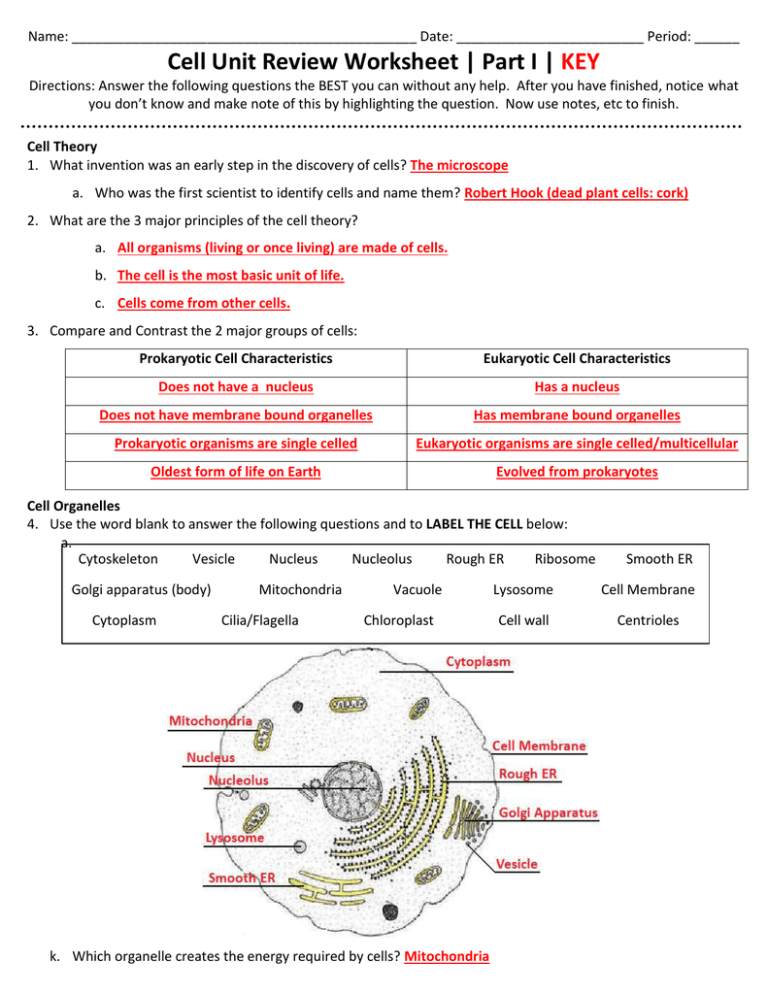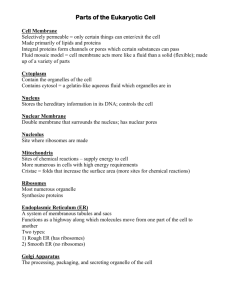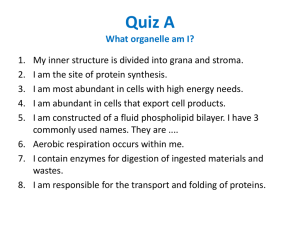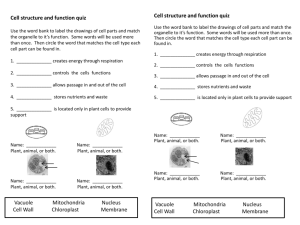Cell Unit Review Worksheet | Part I | KEY
advertisement

Name: ______________________________________________ Date: _________________________ Period: ______ Cell Unit Review Worksheet | Part I | KEY Directions: Answer the following questions the BEST you can without any help. After you have finished, notice what you don’t know and make note of this by highlighting the question. Now use notes, etc to finish. Cell Theory 1. What invention was an early step in the discovery of cells? The microscope a. Who was the first scientist to identify cells and name them? Robert Hook (dead plant cells: cork) 2. What are the 3 major principles of the cell theory? a. All organisms (living or once living) are made of cells. b. The cell is the most basic unit of life. c. Cells come from other cells. 3. Compare and Contrast the 2 major groups of cells: Prokaryotic Cell Characteristics Eukaryotic Cell Characteristics Does not have a nucleus Has a nucleus Does not have membrane bound organelles Has membrane bound organelles Prokaryotic organisms are single celled Eukaryotic organisms are single celled/multicellular Oldest form of life on Earth Evolved from prokaryotes Cell Organelles 4. Use the word blank to answer the following questions and to LABEL THE CELL below: a. Cytoskeleton Vesicle Nucleus Nucleolus Rough ER Ribosome Golgi apparatus (body) Cytoplasm Mitochondria Cilia/Flagella Vacuole Chloroplast k. Which organelle creates the energy required by cells? Mitochondria Smooth ER Lysosome Cell Membrane Cell wall Centrioles l. Which organelles create proteins? Ribosomes m. Which organelles help cells with locomotion (movement)? Cilia/Flagella n. Which organelles processes and transports proteins? Golgi apperatus (body) o. Which organelle contains digestive enzymes to break down foreign invaders? Lysosomes p. Which organelle is a network of fibers that criss-cross to support a cell from the inside? Cytoskeleton q. Which organelle performs photosynthesis to make sugar? Chloroplast r. Which two organelles are ONLY found in animal cells? Lysosomes & Centrioles Which three organelles are ONLY found in plant cells? Cell wall, Central Vacuole, Chloroplasts s. Which organelle is thought to help with cell division in animal cells? Centrioles t. Which organelle is responsible for making ribosomes? Nucleolus u. Which cell part is the internal fluid found in all cells? Cytoplasm v. Which organelle holds DNA and chromosomes? Nucleus w. Which cell part is made of cellulose that provides rigid support? Cell wall Remember plant cells have a central vacuole and animal cells have smaller more numerous vacuoles x. Which organelle is studded with ribosomes & is the site of protein synthesis? Rough ER y. Which organelle breaks down alcohol, and can make lipids? Smooth ER z. Which organelle carries materials from one part of the cell to another? Vesicle aa. Which organelle is a sac filled with fluid inside a cell; it stores materials the cell needs? Vacuole bb. Which cell part is found in plant cells and is OUTSIDE the cell membrane? Cell wall 5. Fill in the blanks regarding the process of protein synthesis: Many organelles are involved in the process of making protein. First the nucleolus makes ribosomes, which exit through pores. The ribosomes then travel to the Rough ER. This is where ribosomes link amino acids to make protein. The protein then travels to the Golgi apparatus, where the proteins are packaged into vesicles which can transport the proteins out of the cell by fusing with the cell membrane. 6. Explain the theory of Endosymbiosis being sure to cite the evidences mentioned in class: Chloroplast & mitochondria were once free-living organisms. Both were engulfed by a larger prokaryotic predator cell. Both gave the larger cell an advantage (be able to make its own food/energy), while the predator cell provided each with shelter/protection. Over time, these larger predator cells could not survive without the mitochondria & chloroplast; and the mitochondria & chloroplast could not survive without the predator cell. Evidence: Mitochondria & chloroplast contain their own DNA, replicate on their own, and contain own ribosomes. Cell Membrane 7. What model have scientists developed to describe the arrangement of molecules that make up a cell membrane? The fluid mosaic model 8. What do the terms selective permeability and semi-permeable have to do with the cell membrane? These terms refer to the fact that the cell membrane allows some materials to move in and out of the membrane, but not all. 9. Using the picture of the cell membrane, label the following: Carbohydrate chain, Embedded Protein, Protein Channel, Cholesterol, Cytoskeleton, Phospholipid (including all of its 3 major parts). 10. List a function of each type of molecule that is embedded in the phospholipid bilayer below: Molecule Cholesterol Function Strengthens and gives flexibility to the cell membrane Proteins Allow the passage of certain materials Carbohydrate Helps to identify the cell to other cells 11. Which part of a phospholipid is polar? 13. Which part of a phospholipid is hydrophilic? The head (glycerol & phosphate) 12. Which part of a phospholipid is hydrophobic? The head (glycerol & phosphate) 14. Which part of a phospholipid is nonpolar? The fatty acid tails The fatty acid tails 15. Explain in your own words: Why do the phospholipids surrounding the cell form a bilayer (why do the tails face the middle/heads face out)? The heads of a phospholipid face towards the inside of the cell and the outside of the cell because they are polar, making them attracted to water and thus hydrophilic. The tails phospholipids face inward, towards each other, because they are nonpolar making them hydrophobic. Because of these characteristics this causes the phospholipids to be arranged in two layers. Answer the following questions about chemical signals: 16. Any chemical signal that binds to a receptor is called a ligand a. Give two examples of these chemical signals: neurotransmitters & hormones 17. List the two types of receptors and their characteristics: a. Intracelluar receptors are found inside the cell. Ligands have to pass through the cell membrane to attach to them. b. Membrane receptors are found embedded (within) the cell membrane. Ligands bind to the receptor proteins outside the cell (they DO NOT pass through the cell membrane).








